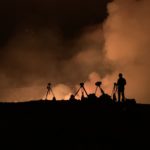Kīlauea volcano is continuing to erupt. Lava is erupting from multiple vents along the floor and western wall of Halemaʻumaʻu crater. All lava activity is confined within Halemaʻumaʻu Crater. Seismicity and volcanic gas emission rates remain elevated.
Sulfur dioxide emission rates remain high and were estimated at around 85,000 tonnes per day just after the eruption started on Wednesday, September 29, 2021 at 3:21 p.m. HST. Seismicity is elevated but stable, with few earthquakes and ongoing volcanic tremor. Summit tiltmeters continued to record slowing deflationary tilt through this afternoon.
The lava lake has been rising approximately one meter (yard) an hour since the eruption began with localized and discontinuous areas of crustal foundering. The maximum fountain height so far, was estimated to be 82-98 ft high, though most fountains are currently only a few meters (yards) high.
No unusual activity has been noted in the Kīlauea East Rift Zone. Ground deformation motion suggests that refilling of the upper East Rift Zone—between the summit and Puʻuʻōʻo — may have slowed slightly since the recent August intrusion. SO2 and hydrogen sulfide (H2S) emissions from Puʻuʻōʻō were below instrumental detection levels when last measured on January 7, 2021.
This new eruption at Kīlauea’s summit is occurring within a closed area of Hawai’i Volcanoes National Park. Therefore, high levels of volcanic gas are the primary hazard of concern, as this hazard can have far-reaching effects down-wind. Large amounts of volcanic gas—primarily water vapor (H2O), carbon dioxide (CO2), and sulfur dioxide (SO2)—are continuously released during eruptions of Kīlauea Volcano. As SO2 is released from the summit, it reacts in the atmosphere to create the visible haze known as vog (volcanic smog) that has been observed downwind of Kīlauea. Vog creates the potential for airborne health hazards to residents and visitors, damages agricultural crops and other plants, and affects livestock. Vog information can be found at https://vog.ivhhn.org/.
Additional hazards include Pele’s hair and other lightweight volcanic glass fragments from the lava fountains that will fall downwind of the fissure vents and dust the ground within a few hundred meters (yards) of the vent (s). Strong winds may waft lighter particles to greater distances. Residents should minimize exposure to these volcanic particles, which can cause skin and eye irritation.
Other significant hazards also remain around Kīlauea caldera from Halemaʻumaʻu crater wall instability, ground cracking, and rockfalls that can be enhanced by earthquakes within the area closed to the public. This underscores the extremely hazardous nature of Kīlauea caldera rim surrounding Halemaʻumaʻu crater, an area that has been closed to the public since late 2007.
For discussion of Kīlauea hazards, please see: https://www.usgs.gov/observatories/hawaiian-volcano-observatory/hazards
The Hawaiian Volcano Observatory (HVO) continues to closely monitor Kīlauea Volcano and will continue to issue daily updates until further notice.
Photo credit: USGS
